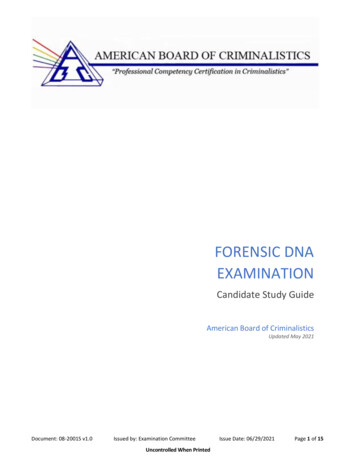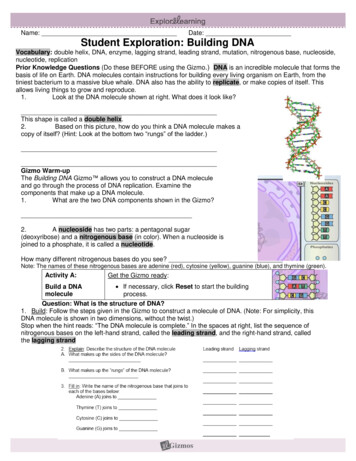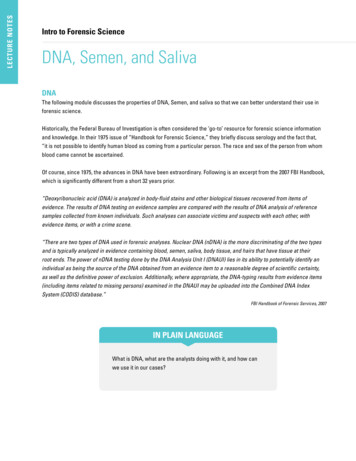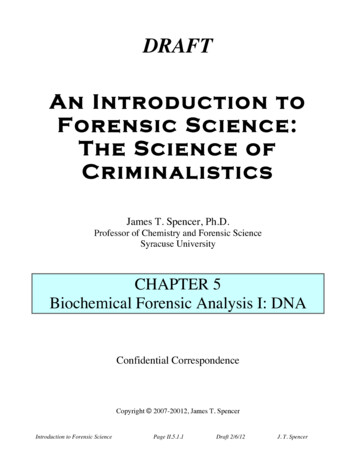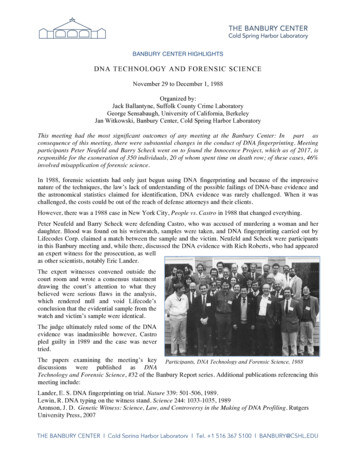
Transcription
BANBURY CENTER HIGHLIGHTSDNA TECHNOLOGY AND FORENSIC SCIENCENovember 29 to December 1, 1988Organized by:Jack Ballantyne, Suffolk County Crime LaboratoryGeorge Sensabaugh, University of California, BerkeleyJan Witkowski, Banbury Center, Cold Spring Harbor LaboratoryThis meeting had the most significant outcomes of any meeting at the Banbury Center: In part asconsequence of this meeting, there were substantial changes in the conduct of DNA fingerprinting. Meetingparticipants Peter Neufeld and Barry Scheck went on to found the Innocence Project, which as of 2017, isresponsible for the exoneration of 350 individuals, 20 of whom spent time on death row; of these cases, 46%involved misapplication of forensic science.In 1988, forensic scientists had only just begun using DNA fingerprinting and because of the impressivenature of the techniques, the law’s lack of understanding of the possible failings of DNA-base evidence andthe astronomical statistics claimed for identification, DNA evidence was rarely challenged. When it waschallenged, the costs could be out of the reach of defense attorneys and their clients.However, there was a 1988 case in New York City, People vs. Castro in 1988 that changed everything.Peter Neufeld and Barry Scheck were defending Castro, who was accused of murdering a woman and herdaughter. Blood was found on his wristwatch, samples were taken, and DNA fingerprinting carried out byLifecodes Corp. claimed a match between the sample and the victim. Neufeld and Scheck were participantsin this Banbury meeting and, while there, discussed the DNA evidence with Rich Roberts, who had appearedan expert witness for the prosecution, as wellas other scientists, notably Eric Lander.The expert witnesses convened outside thecourt room and wrote a consensus statementdrawing the court’s attention to what theybelieved were serious flaws in the analysis,which rendered null and void Lifecode’sconclusion that the evidential sample from thewatch and victim’s sample were identical.The judge ultimately ruled some of the DNAevidence was inadmissible however, Castropled guilty in 1989 and the case was nevertried.The papers examining the meeting’s key Participants, DNA Technology and Forensic Science, 1988discussions were published as DNATechnology and Forensic Science, #32 of the Banbury Report series. Additional publications referencing thismeeting include:Lander, E. S. DNA fingerprinting on trial. Nature 339: 501-506, 1989.Lewin, R. DNA typing on the witness stand. Science 244: 1033-1035, 1989Aronson, J. D. Genetic Witness: Science, Law, and Controversy in the Making of DNA Profiling. RutgersUniversity Press, 2007THE BANBURY CENTER Cold Spring Harbor Laboratory Tel. 1 516 367 5100 BANBURY@CSHL.EDU
Preface to Banbury Reports 32: DNA TECHNOLOGY AND FORENSIC SCIENCEDNA technology is moving rapidly from the research laboratory into diverse areas of practical application.Its use in forensic science has generated considerable excitement, both in the criminal justice community andin the popular media. There are several reasons for this: First, people are always interested in crime anddetective work, particularly when crimes of violence are involved and the detective work has some noveltwist. Second, there is the promise of a remarkable advance in criminal identification; in the near future,criminals might be identified definitively from the DNA evidence that they leave behind. leading to the DNAidentification records that might be used for identification purposes in the same way that fingerprint recordsare currently used. Finally, there is a general fascination with the idea that we are in some way unlocking theblack box of identity. To use DNA technology to detect agene for a disease is "simply" another medical advance.To use DNA technology to identify or to characterize anindividual carries the implication that the uniqueness of ahuman being, resident in that person's DNA, can bedeciphered and written down. It is not too farfetched tosee a similarity with the belief of some peoples thatphotographs can capture a person’s soul.The first flush of excitement is now giving way to therealities of broad implementation, which include both theproblems of transforming a research technique into aroutine procedure and a concern for the legal and ethicalissues involved. This, in turn, is bringing forth questionsEric Lander, Rich Roberts, Peter Neufeldas to the direction the criminal justice system should goand how fast. Within the professional confines of forensic science, there are probably more committeeslooking into DNA implementation than all other issues combined. The legal community–prosecution,defense, and the judiciary–have set up advisory committees. Some states have had legislative hearings onDNA implementation or set up panels to review it. No doubt others will follow.This volume examines some of the key questions surrounding the application of DNA technology in the legalsetting and focus on questions of policy, not technology. The following is a brief description of each of thesections that make up this volume.Section 1 considers the forensic use of genetic information from a broad social and legal perspective. Whatimpact will DNA evidence have on the justice system? Can and should DNA taken for identification be usedto determine other genetic characteristics? What constraints should be placed on the use of geneticinformation?Section 2 focuses on the specific legal issues of admissibility and interpretation in court. What are the rulesthat govern admissibility? Should there be different standards for DNA evidence and the information derivedthere-from? Are there flaws in DNA technology or in the information it can provide that limit applicability?Section 3 addresses issues associated with the implementation of DNA technology in the forensic setting.What has been the experience with implementation to date? How do we assure a high standard ofperformance? Should there be regulation or accreditation of laboratories that provide DNA services andshould this include private as well as public laboratories? If so, what body should be responsible, and howshould it be on a state or national level?Section 4 outlines current and potential future approaches to the use of DNA technology for identificationpurposes. How do the different approaches compare? What is the potential for simplification of theTHE BANBURY CENTER Cold Spring Harbor Laboratory Tel. 1 516 367 5100 BANBURY@CSHL.EDU
techniques by using new procedures like polymerase chain reaction or developing robotic systems toimprove reliability?Section 5 focuses on the issue of DNA databank development. How are existing databanks constructed and how is the informationin them managed? How much standardizationis necessary? What are the economics of databank development and operation?This wide range of topics emphasizing therelationship between modern biology andsociety is in keeping with the tradition of theBanbury Center. We believe that this is thefirst occasion on which such a diverse groupC. Thomas Caskey and Jan Bashinskiof people – molecular biologists, legalauthorities, forensic scientists, and policy analysts – has been brought together to discuss these issues in aworkshop setting. We thank the participant for not being shy and for speaking their minds; the discussionswere freewheeling, open and informative. The authors alone are responsible for the accuracy of their chaptersand the opinions expressed are their own.We also thank the staff of the Banbury Center, particularly Bea Toliver for her help and patience with theorganization of the meeting and Katya Davey for her graciousness in making the participants welcome atRobertson House. We express our appreciation to the Publications staff including Dorothy Brown, NadineDumser, and Inez Sialiano, for their assistance in the preparation of this volume.We are particularly grateful to Cellmark Diagnostics (ICI Americas, Inc.), Collaborative Research, LifecodesCorporation, and the National Institute of Justice (U.S. Department of Justice) for underwriting the costs ofthe conference. We hope that the proceedings of this conference provide some useful and unusualperspectives on the exciting area of DNA technology and forensic science and that they will serve as thestarting point for further developments.J. Ballantyne, G. Sensabaugh, J. Witkowski, 1989THE BANBURY CENTER Cold Spring Harbor Laboratory Tel. 1 516 367 5100 BANBURY@CSHL.EDU
PROGRAMSession I: Forensic Use of Genetic Information -Legal and Social IssuesJoseph L. Peterson, University of Illinois at Chicago, Chicago, IllinoisBiological evidence and its impact on judicial decision making.Arno G. Motulsky, University of Washington School of Medicine, Seattle, WashingtonGenetics and society.Dorothy Nelkin, New York University, New York, New YorkSociety's use of data.Alan Westin, Columbia University, New York, New York, New YorkGeneral aspects of privacy.Philip Reilly, Shriver Center for Mental Retardation, Waltham, MassachusettsRegulation of access to genetic data.Session II: Basic Issues - Legal and ScientificPeter Neufeld, New York, New YorkThe Frye test and the admissibility of scientific evidence.Rockne P. Harmon, Alameda County District Attorney's Office, Oakland, CaliforniaThe Frye test: Considerations for DNA fingerprinting.Michael Katzer, Office of the District Attorney, Albany, New YorkA review of present cases.C. Thomas Caskey, Baylor College of Medicine, Houston, TexasA critical evaluation of the laboratory techniques.Eric S. Lander, Whitehead Institute for Biomedical Research, Cambridge, MassachusettsThe requirements for population studies.Session III: Transfer of DNA technology to the forensic laboratoryJan Bashinski, Oakland Police Department Crime Laboratory, Oakland, CaliforniaLaboratory accreditation, training and certification of staff in the forensic context.Michael Baird, Lifecodes Corporation, Stamford, ConnecticutQuality control and quality assurance in medical/genetics laboratoriesEdward T. Blake, Forensic Science Associates, Richmond, CaliforniaDNA analysis and its integration into traditional forensic serology.Session IV: Practical experiences of the transfer of DNA technology to the forensic laboratoryDiscussants: John W. Hicks, F.B.I. Laboratory Division, Washington, D.C.John Ballantyne, Office of the Medical Examiner, County of Suffolk, Hauppauge, New YorkHenry Lee, Connecticut State Police Forensic Science Laboratory, Meriden, ConnecticutWillard Carl Stuver, Metro-Dade Police Department Crime Laboratory, Miami, FloridaBarry Gaudette, Royal Canadian Mounted Police Central Forensic Laboratory, Ottawa, CanadaDavid Werrett, Home Office Research Establishment, Reading, United KingdomTHE BANBURY CENTER Cold Spring Harbor Laboratory Tel. 1 516 367 5100 BANBURY@CSHL.EDU
Session V: Advanced DNA Techniques with Application in the Forensic LaboratoryShannon Odelberg, University of Utah School of Medicine, Salt Lake City, UtahTandemly repeated DNA and its applications in forensic biology.Daniel D. Garner, Cellmark Diagnostics, Germantown, MarylandCurrent case experience with single locus hypervariable probes.Russell Higuchi, Cetus Corporation, Emeryville, CaliforniaApplications of the polymerase chain reaction in forensic science.Alex J. Jeffreys, University of Leicester, Leicester, United KingdomMinisatellite probes and the polymerase chainGeorge L. Trainor, DuPont Company, Wilmington, DelawareFluorescence detection nucleic acid analysis.Michael Hunkapiller, Applied Biosystems, Inc., Foster City, CaliforniaDetection systems for DNA sequencing and specific nucleotide sequences.Session VI: Establishment, Maintenance and Regulation of DatabasesStanley D. Rose, Collaborative Research, Inc., Bedford, MassachusettsStandardization of systems - essential or desirable?Emmet A. Rathbun, F.B.I. National Crime Information Center, Washington, D.C.The NCIC experience.Kenneth K. Kidd, Yale University School of Medicine, New Haven, ConnecticutThe human gene mapping database.Thomas G. Marr, Los Alamos National Laboratory, New MexicoAn analysis system and database for gel images.Danny Boggs, U.S. Court of Appeals Louisville, KentuckySummaryTHE BANBURY CENTER Cold Spring Harbor Laboratory Tel. 1 516 367 5100 BANBURY@CSHL.EDU
DNA TECHNOLOGY AND FORENSIC SCIENCE: ParticipantsBernard AuchterNational Institute of JusticeUSAMichael BairdLifecodes CorporationUSAJohn BallantyneOffice of the Medical Examiner, Sussex CountyUSAJan BashinskiOakland Police Dept. Crime LabUSAElizabeth BazanCongressional Research ServiceUSAPaul BillingsHarvard Medical SchoolUSADanny BoggsU.S. Court of AppealsUSABruce BudowleLaboratory Division, FBIUSAC. Thomas CaskeyBaylor College of MedicineUSADaniel GarnerCellmark DiagnosticsUSABarry GaudetteRoyal Canadian Mounted PoliceCanadaRobert GottheinerCellmark DiagnosticsUSALionel GrundyPolice Requirements Support UnitUnited KingdomRockne HarmonAlameda County District Attorney's OfficeUSAJohn HicksLaboratory Division FBIUSARussell HiguchiCetus CorporationUSAMichael HunkapillerApplied BiosystemsUSAAlec JeffreysUniversity of LeicesterUnited KingdomMichael KatzerDA’s Office, County of Albany, NYUSAKenneth KiddYale University School of MedicineUSAJoseph KochanskiNational Institute of JusticeUSAEric LanderWhitehead InstituteUSAHenry LeeConnecticut State PoliceUSAThomas MarrLos Alamos National LaboratoryUSAArno MotulskyUniversity of Washington School of MedicineUSADorothy NelkinNew York UniversityUSATHE BANBURY CENTER Cold Spring Harbor Laboratory Tel. 1 516 367 5100 BANBURY@CSHL.EDU
Peter NeufeldNew YorkUSARobyn NishimiOffice of Technology Assessment, US CongressUSAKevin O'ConnorOffice of Technology Assessment, US CongressUSAShannon OdelbergUniversity of UtahUSAJoseph PetersonUniversity of Illinois at ChicagoUSAEnrico PicozzaPerkin-Elmer CorporationUSAEmmet RathbunNational Criminal Information Center, FBIUSAPhilip ReillyShriver Center for Mental RetardationUSARichard RobertsCold Spring Harbor LaboratoryUSAStanley RoseCollaborative Research Inc.USABarry ScheckCardozo Criminal Law ClinicUSAGeorge SensabaughUniversity of CaliforniaUSADonna-Marie SeyfriedPerkin-Elmer CorporationUSAMarcello SiniscalcoMemorial Sloan-Kettering Cancer CenterUSAWillard StuverMetro-Dade Police DepartmentUSAGeorge TrainorDu Pont Merck Pharm. CompanyUSADavid WerrettHome Office Research Establishment, UKUnited KingdomAlan WestinColumbia UniversityUSAJan WitkowskiBanbury Center, Cold Spring HarborLaboratoryUSATHE BANBURY CENTER Cold Spring Harbor Laboratory Tel. 1 516 367 5100 BANBURY@CSHL.EDU
involved misapplication of forensic science. In 1988, forensic scientists had only just begun using DNA fingerprinting and because of the impressive nature of the techniques, the law’s lack of understanding of the possible failings of DNA-base evidence and the astronomical statistics claime

